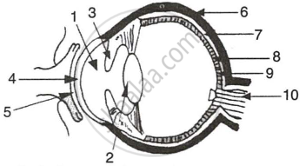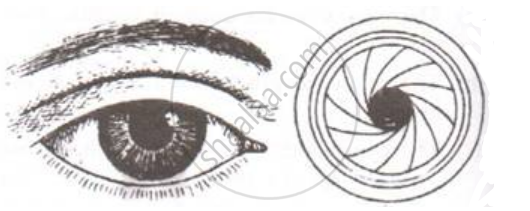Advertisements
Advertisements
Question
The figure given below refers to the vertical section of the eye of a mammal. Study the figure carefully and answer the following questions.
 |
- Label the guidelines shown as 1 to 10.
- Write one important role of parts shown as 3 and 7.
- Write one structural difference between the parts shown as 9 and 10.
- Mention one functional difference between the parts shown as 6 and 8.
Solution
-
- Aqueous Humour
- Lens
- Iris
- Cornea
- Conjunctiva
- Sclera
- Choroid
- Retina
- Fovea centralis
- Optic Nerve
- Iris: The iris has radial and circular muscles that can enlarge or constrict the pupil.
This regulates the amount of light entering the eyes.
Choroid: The choroid includes blood veins that supply the eyeball. - Fovea centralis: The fovea is located in the centre of the macula lutea of the retina.
Optic nerve: The optic nerve connects the eye to the brain, which carries impulses formed by the retina. - Sclera: The sclera is a protective, tough white behind the retina.
Cornea: The cornea is a transparent coating that shields the eye's coloured component and allows light to pass through.
RELATED QUESTIONS
Explain the following:
Mechanism of generation of light-induced impulse in the retina.
Where does the greatest degree of refraction of light occur in the eye?
Fill in the following blank with suitable word:
Most of the refraction of light rays entering the eye occurs at the outer surface of the.............
The term " accommodation" as applied to the eye, refers to its ability to:
(a) control the light intensity falling on the retina
(b) erect the inverted image formed on the retina
(c) vary the focal length of the lens
(d) vary the distance between the lens and retina
A man driving a car can read a distant road sign clearly but finds difficulty in reading the odometer on the dashboard of the car. Which of the following statement is correct about this man?
(a) The near point of his eyes has receded away.
(b) The near point of his eyes has come closer to him.
(c) The far point of his eyes has receded away.
(d) The far point of his eyes has come closer to him.
State whether the following statement is true or false:
Rabbit has eyes which look sideways.
Define the following:
Power of accommodation
The figure below compares a part of our eye with a part of a photographic camera.

Explain the mode of working and the functions of the parts of the eye mentioned above.
Name the following:
The focal length of the lens is altered by the contraction of which type of muscles.
Give Technical Term:
The cells of the retina that are sensitive to colour.
Give Technical Term:
The nutritive layer of the eye which also presents reflection of light.
Complete the following sentence with appropriate Word
The part of the human eye where rod cells and cone cells are located is the:
Write an Explanation.
Minimum distance of distinct vision
Boojho while waving his hand very fast in front of his eyes, observes that his fingers appear blurred. What could be the reason for it?
What is ‘white of the eye’?
Describe the parts in the external structure of the eye.
Match the following:
| Column - I | Column - II |
| 1. Retina | a) Path way of light |
| 2. Pupil | b) Far point comes closer |
| 3. Ciliary muscles | c) near point moves away |
| 4. Myopia | d) Screen of the eye |
| 5. Hypermetropia | e) Power of accommodation |
With reference to human eye, answer the following question.
What is aqueous humor?
Match the following:
| Column - I | Column - II |
| 1. Retina | a. Path way of light |
| 2. Pupil | b. Far point comes closer |
| 3. Ciliary muscles | c. near point moves away |
| 4. Myopia | d. Screen of the eye |
| 5. Hypermetropia | e. Power of accommodation |
With reference to human eye answer the question that follow:
Name the part of the eye associated with the regulation of the shape of lens.
